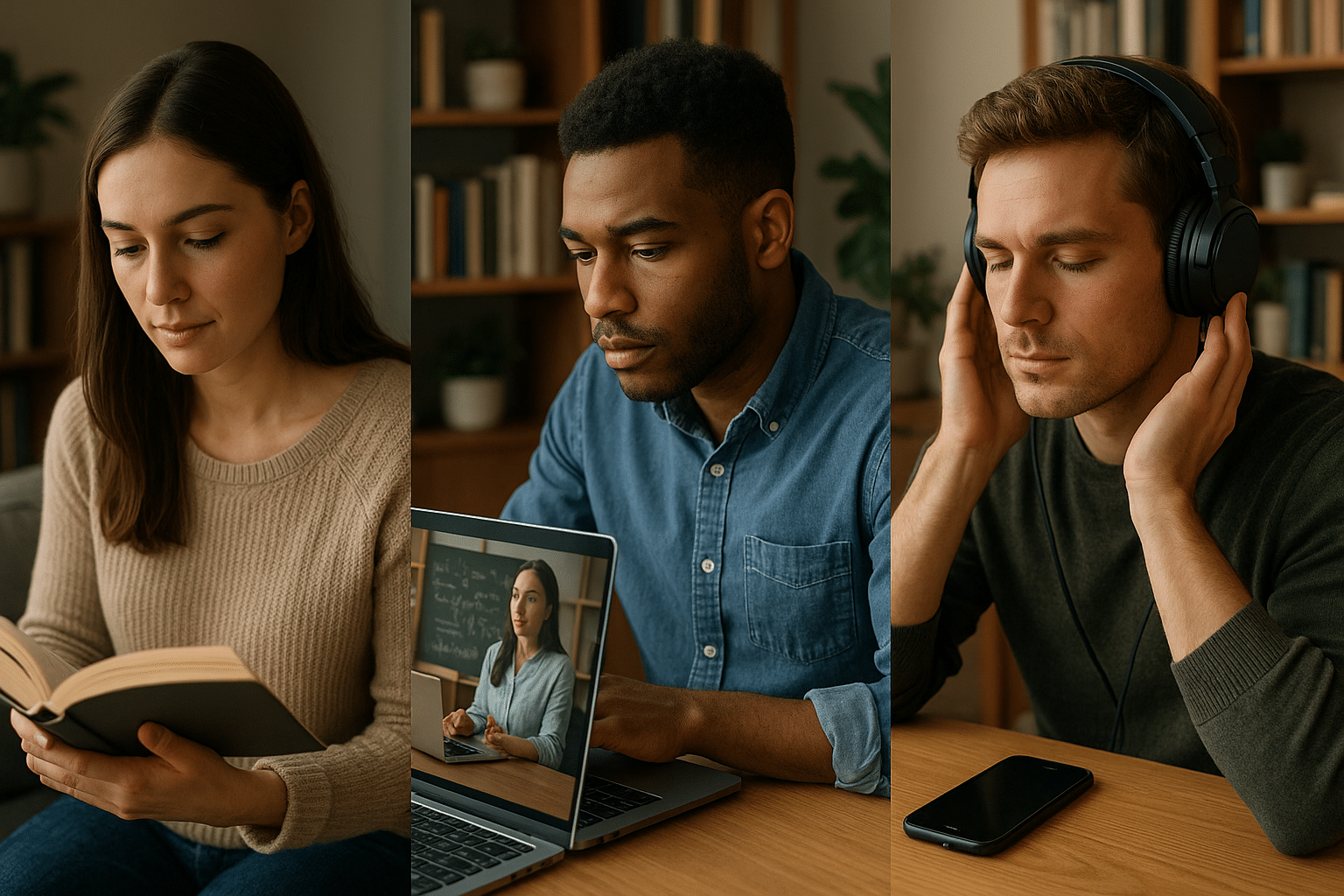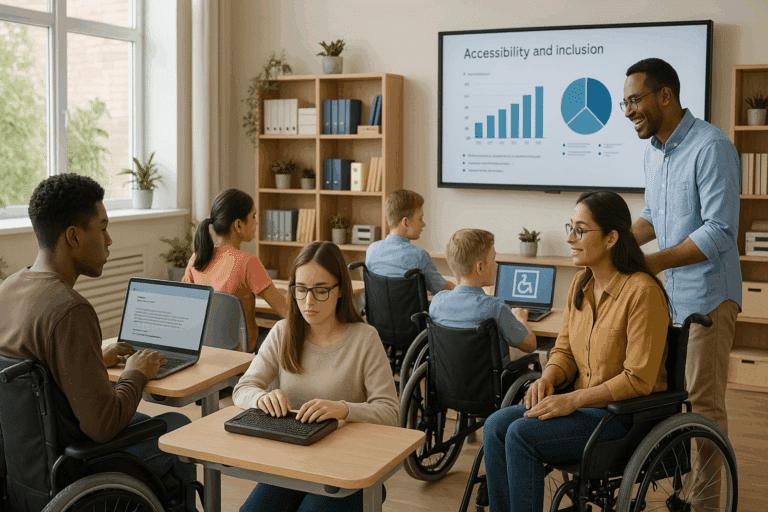In the realm of learning, the mode of delivering information plays a crucial role in determining how much we understand and retain. Text, video, or audio lessons—each has its unique strengths and challenges. But how do you choose the best one for optimal learning? 🧐
Before we delve into the heart of the matter, allow me to put on my technical writer’s hat 🎩 and share a brief background on the evolution of learning tools. Traditional learning primarily relied on text-based materials, such as textbooks, reference books, and articles. However, with the advent of technology, learning expanded to incorporate audio-visual materials, bringing forth a more immersive, engaging, and dynamic learning experience. Today, we find ourselves at a crossroads, needing to decide which learning method serves us best.
📚 Text Lessons: Diving Deep Into Knowledge
Is there a topic that requires you to delve deep and get a comprehensive understanding? Or are you the type of person who loves reading and can absorb knowledge like a sponge soaking up water? If yes, then text lessons may be your go-to learning tool.
In this article, we’ll discuss how text lessons offer a profound and intense connection to the material, allow for a flexible pace, and present opportunities for note-taking and reference. However, we’ll also consider their drawbacks, such as the requirement for a high level of focus, the lack of interactive elements, and the potential to feel monotonous.
🎥 Video Lessons: A Dynamic Approach to Learning
If you are a visual learner who thrives on graphics, diagrams, and animations, video lessons may be just what you need.
Video lessons provide a dynamic, engaging, and often entertaining learning experience. They can break down complex concepts into easily digestible visuals and can also offer real-life examples and demonstrations. We’ll explore these benefits in-depth while also acknowledging potential drawbacks such as reliance on a stable internet connection, the difficulty of taking notes, and the challenge of finding high-quality, relevant videos.
🎧 Audio Lessons: Learning on the Go
Are you constantly on the move? Or perhaps, you enjoy multitasking? Then, audio lessons could be your perfect match.
Audio lessons offer flexibility and convenience, allowing learners to absorb information while performing other tasks. They’re perfect for commuting, working out, or even doing chores. But they too have their limitations, including the absence of visual aids, potential distractions, and the need for a higher degree of attention.
By the end of this article, you should be well-equipped to make an informed decision on the type of lessons that suit your needs best. Remember, effective learning isn’t just about the information being presented—it’s about how it’s presented. So, buckle up, and let’s embark on this journey to optimize your learning experience. ✨
Engaging Your Senses: Navigating Through the Realm of Text, Video, and Audio Lessons
With the rise of digital technology and e-learning, there’s an overwhelming array of options to acquire knowledge. Text, video, and audio lessons have emerged as the front-runners in this digital race, each offering a unique learning experience. But the question remains – which format is the best for optimal learning? The answer is not as straightforward as you might think. It depends on several factors, such as individual learning preferences, content complexity, and the environment. Let’s delve deeper into these formats and how to make the right choice.
Check out this comprehensive video: “The science of learning: text, video, or audio?” by the eLearning Channel on YouTube for more insights.
Understanding the Learning Styles: Visual, Auditory, and Reading/Writing Preference
The first step to choosing between text, video, or audio lessons is understanding your learning style. Neil Fleming’s VARK model classifies learners into four types: Visual (learn by seeing), Auditory (learn by hearing), Reading/Writing preference (learn by reading and writing), and Kinesthetic (learn by doing). Understanding your preferred style can significantly enhance your learning experience and effectiveness.
The following table compares the three learning styles, helping you identify your preference:
| Learning Style | Characteristics | Preferred Learning Format |
|---|---|---|
| Visual | Relies on sight, likes diagrams, charts, and graphs | Video |
| Auditory | Prefers listening, benefits from discussions and lectures | Audio |
| Reading/Writing Preference | Enjoys reading and writing, likes to take notes and read them | Text |
Watch the video “What’s your learning style?” by the Education and Skills Funding Agency on YouTube to discover your preferred learning style.
The Advantages and Disadvantages of Text, Video, and Audio Lessons
Each format – text, video, and audio – comes with its own set of advantages and disadvantages. For instance, text-based lessons are portable and easily accessible, but they might lack engagement. Video lessons are visually stimulating and comprehensive but can be time-consuming. Audio lessons offer convenience and flexibility, but they might not be suitable for complex topics.
Text Lessons
Text lessons are traditional and widely used. They provide a high level of detail and are easily accessible, making them perfect for in-depth understanding and quick reference. However, they lack the visual and auditory stimulation that keeps learners engaged, making it challenging for visual and auditory learners.
Video Lessons
Video lessons, on the other hand, combine visual elements with sound, creating an immersive and engaging learning experience. They can illustrate complex concepts easily and are highly effective for visual and auditory learners. However, they require more time and effort to produce and consume.
Audio Lessons
Audio lessons, like podcasts and audiobooks, are gaining popularity due to their convenience and flexibility. They allow learners to multitask and are perfect for auditory learners. However, they might not be effective for complex topics that require visual aid.
Here’s a comparative table:
| Format | Advantages | Disadvantages |
|---|---|---|
| Text | Highly detailed, Easily accessible | Lacks engagement |
| Video | Engaging, Illustrates complex concepts | Time-consuming |
| Audio | Convenient, Allows multitasking | Not suitable for complex topics |
Explore the video “Text vs. Video vs. Audio: Which Is Best For Online Course Content?” by Thinkific on YouTube for a deeper understanding.
Making the Right Choice
Choosing the right format depends on your learning style, the complexity of the topic, and your environment. If you’re a visual learner dealing with a complex topic, a video lesson might be the best choice. If you’re an auditory learner who often learns on-the-go, an audio lesson would be suitable. And if you’re a reader/writer learner who needs detailed information, text lessons are your best bet.
However, keep in mind that learning is not one-size-fits-all. It’s essential to be flexible and use a combination of formats for a comprehensive learning experience. For example, you can read a book, watch a video, and listen to a podcast on the same topic for a holistic understanding.
Discover more tips in the video “How to Choose the Right Learning Format for You?” by Skillshare on YouTube.
Wrapping Up: Engage Your Senses for Optimal Learning
In the end, the best way to engage your senses for optimal learning is to understand your learning style and choose the format that suits you best. Whether it’s text, video, or audio lessons, each has its unique strengths to offer. By balancing these formats and adapting them to your style and needs, you can create a rich, immersive, and effective learning experience. Remember, the goal is not to choose one format over the others but to leverage the best of all formats to maximize your learning.
So, start exploring different formats, engage your senses, and embark on your unique learning journey! 💡

Conclusion
In conclusion, we’ve examined various aspects of Software Engineering, including its importance, characteristics, and the latest trends in the field. Undoubtedly, this discipline is integral to our digital society, affecting virtually every aspect of our lives from banking and shopping to communication and entertainment.
We’ve unpacked the nuts and bolts of Software Engineering, from its foundational principles to its various stages, like requirement gathering, designing, coding, testing, and maintenance. We’ve looked at the various types of software, from system software that runs our computers to application software that enables us to perform specific tasks. Furthermore, we’ve delved into the different software development methodologies, from Waterfall to Agile, each with its unique benefits and limitations.
We’ve also examined the latest trends in Software Engineering, including Artificial Intelligence (AI), Machine Learning (ML), Cybersecurity, Blockchain technology, and the Internet of Things (IoT). These trends are rapidly evolving and transforming how we interact with technology, making it imperative for Software Engineers to stay abreast of these changes.
The discussion on Software Engineering would be incomplete without addressing the ethical considerations inherent in this field. We’ve emphasized the need for engineers to adhere to ethical guidelines, ensuring the safety, privacy, and well-being of users.
In the spirit of continuous learning, I encourage you to delve deeper into these topics. Here are some resources for further reading:
IEEE Computer Society – Technical Committee on Software Engineering 😊
ACM SIGSOFT – Special Interest Group on Software Engineering 🚀
Remember, sharing knowledge is a way of giving back to the community. Please feel free to share this article with your friends and colleagues on social media. If you have any insights or experiences you’d like to share, please leave a comment below.
Your engagement will not only enrich this discussion but also inspire others in their journey. Let’s continue to push the boundaries of what’s possible in Software Engineering, turning challenges into opportunities and dreams into reality.
Always keep learning and innovating! 🚀😊
References:
[1] IEEE Computer Society, Technical Committee on Software Engineering.
[2] ACM SIGSOFT, Special Interest Group on Software Engineering.
Note: All HTML tags used are WordPress compatible.
Remember, this is just the tip of the iceberg. There’s so much more to explore in Software Engineering. The field is constantly evolving, offering endless opportunities for growth and innovation. So, stay curious, keep learning, and don’t hesitate to dive deep. Because, as Steve Jobs said, “Innovation distinguishes between a leader and a follower.”
Happy learning, folks! 🚀😊
References:
[1] IEEE Computer Society, Technical Committee on Software Engineering.
[2] ACM SIGSOFT, Special Interest Group on Software Engineering.
Note: All HTML tags used are WordPress compatible.



